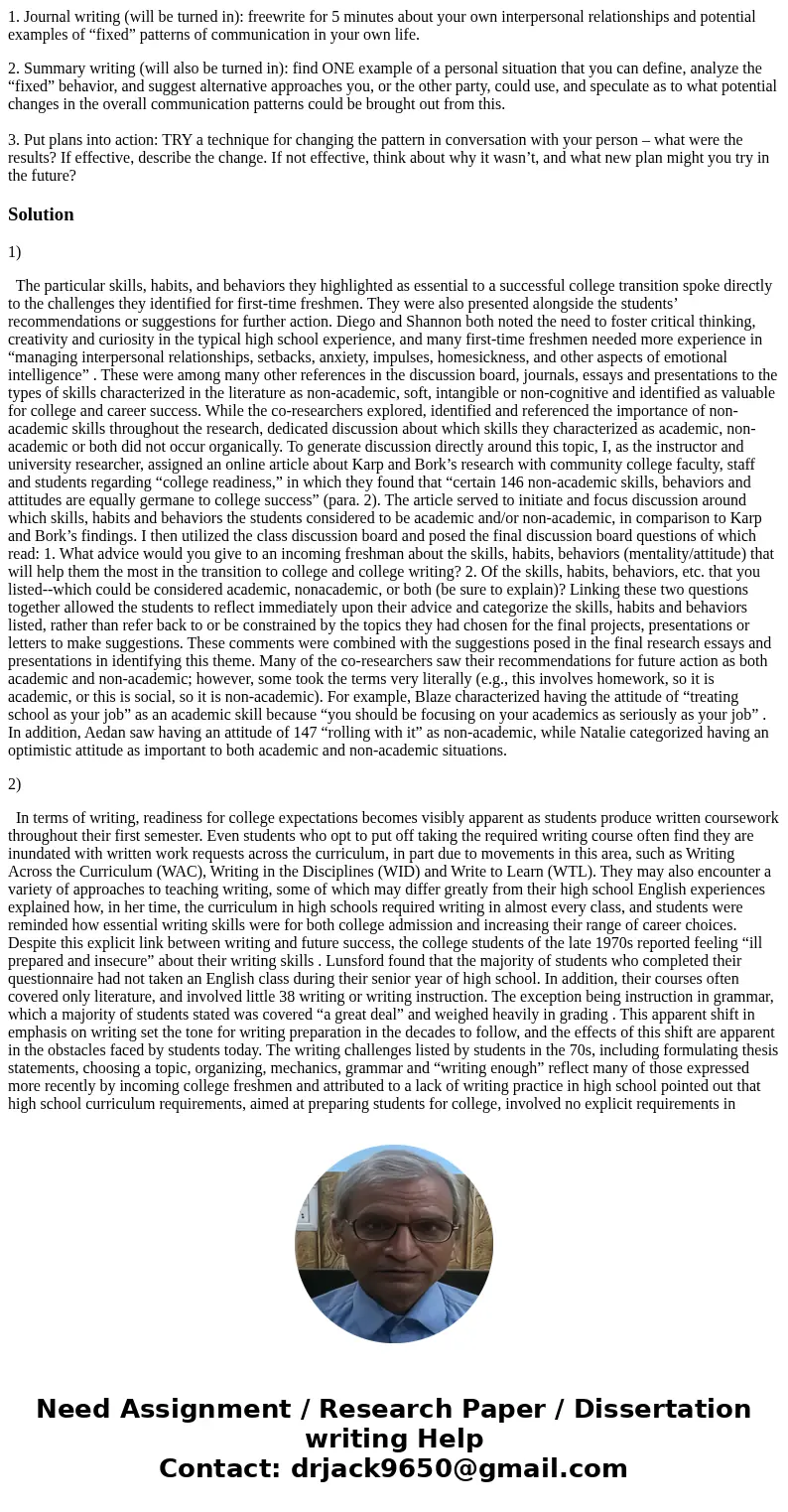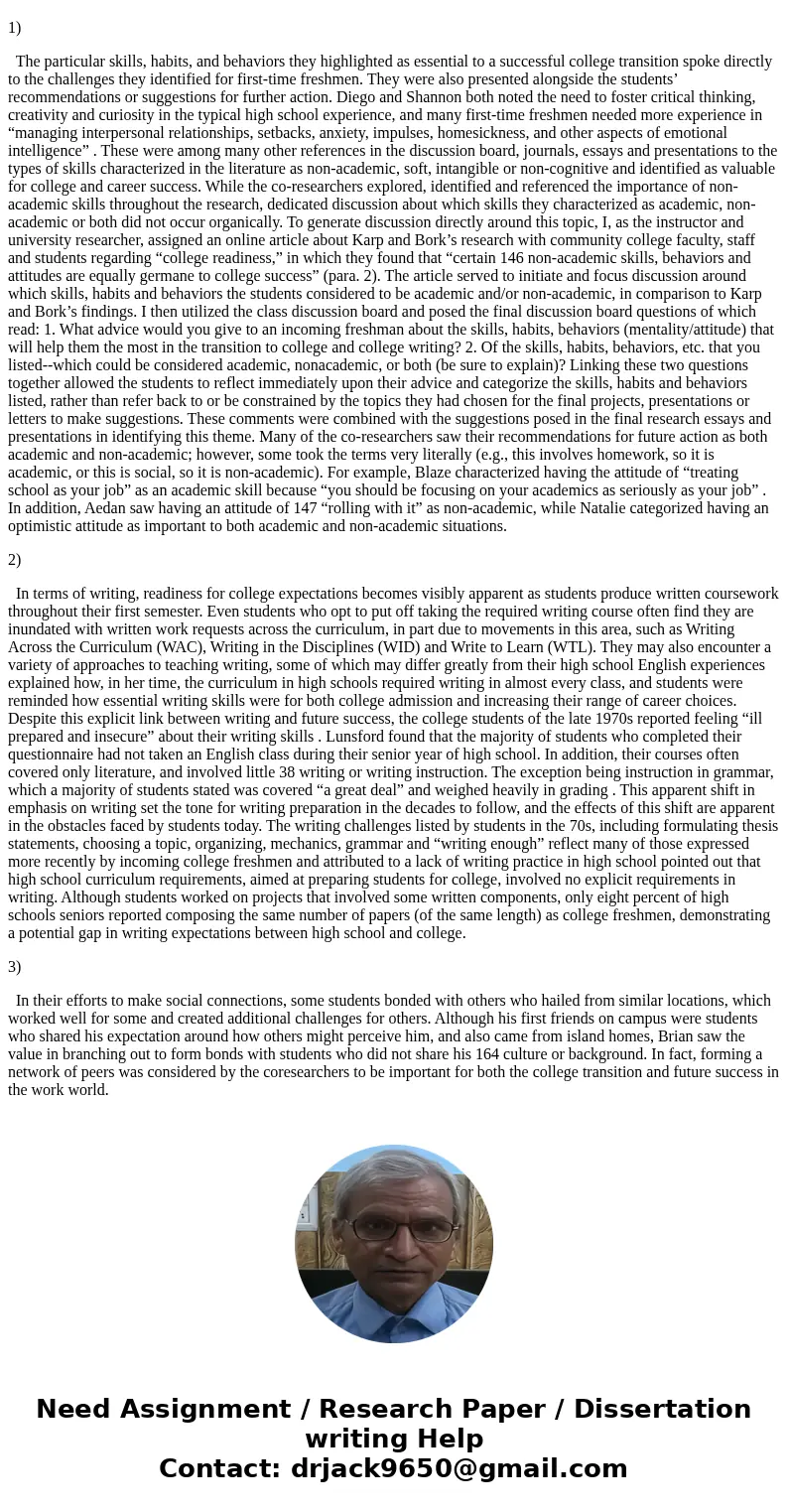1 Journal writing will be turned in freewrite for 5 minutes
1. Journal writing (will be turned in): freewrite for 5 minutes about your own interpersonal relationships and potential examples of “fixed” patterns of communication in your own life.
2. Summary writing (will also be turned in): find ONE example of a personal situation that you can define, analyze the “fixed” behavior, and suggest alternative approaches you, or the other party, could use, and speculate as to what potential changes in the overall communication patterns could be brought out from this.
3. Put plans into action: TRY a technique for changing the pattern in conversation with your person – what were the results? If effective, describe the change. If not effective, think about why it wasn’t, and what new plan might you try in the future?
Solution
1)
The particular skills, habits, and behaviors they highlighted as essential to a successful college transition spoke directly to the challenges they identified for first-time freshmen. They were also presented alongside the students’ recommendations or suggestions for further action. Diego and Shannon both noted the need to foster critical thinking, creativity and curiosity in the typical high school experience, and many first-time freshmen needed more experience in “managing interpersonal relationships, setbacks, anxiety, impulses, homesickness, and other aspects of emotional intelligence” . These were among many other references in the discussion board, journals, essays and presentations to the types of skills characterized in the literature as non-academic, soft, intangible or non-cognitive and identified as valuable for college and career success. While the co-researchers explored, identified and referenced the importance of non-academic skills throughout the research, dedicated discussion about which skills they characterized as academic, non-academic or both did not occur organically. To generate discussion directly around this topic, I, as the instructor and university researcher, assigned an online article about Karp and Bork’s research with community college faculty, staff and students regarding “college readiness,” in which they found that “certain 146 non-academic skills, behaviors and attitudes are equally germane to college success” (para. 2). The article served to initiate and focus discussion around which skills, habits and behaviors the students considered to be academic and/or non-academic, in comparison to Karp and Bork’s findings. I then utilized the class discussion board and posed the final discussion board questions of which read: 1. What advice would you give to an incoming freshman about the skills, habits, behaviors (mentality/attitude) that will help them the most in the transition to college and college writing? 2. Of the skills, habits, behaviors, etc. that you listed--which could be considered academic, nonacademic, or both (be sure to explain)? Linking these two questions together allowed the students to reflect immediately upon their advice and categorize the skills, habits and behaviors listed, rather than refer back to or be constrained by the topics they had chosen for the final projects, presentations or letters to make suggestions. These comments were combined with the suggestions posed in the final research essays and presentations in identifying this theme. Many of the co-researchers saw their recommendations for future action as both academic and non-academic; however, some took the terms very literally (e.g., this involves homework, so it is academic, or this is social, so it is non-academic). For example, Blaze characterized having the attitude of “treating school as your job” as an academic skill because “you should be focusing on your academics as seriously as your job” . In addition, Aedan saw having an attitude of 147 “rolling with it” as non-academic, while Natalie categorized having an optimistic attitude as important to both academic and non-academic situations.
2)
In terms of writing, readiness for college expectations becomes visibly apparent as students produce written coursework throughout their first semester. Even students who opt to put off taking the required writing course often find they are inundated with written work requests across the curriculum, in part due to movements in this area, such as Writing Across the Curriculum (WAC), Writing in the Disciplines (WID) and Write to Learn (WTL). They may also encounter a variety of approaches to teaching writing, some of which may differ greatly from their high school English experiences explained how, in her time, the curriculum in high schools required writing in almost every class, and students were reminded how essential writing skills were for both college admission and increasing their range of career choices. Despite this explicit link between writing and future success, the college students of the late 1970s reported feeling “ill prepared and insecure” about their writing skills . Lunsford found that the majority of students who completed their questionnaire had not taken an English class during their senior year of high school. In addition, their courses often covered only literature, and involved little 38 writing or writing instruction. The exception being instruction in grammar, which a majority of students stated was covered “a great deal” and weighed heavily in grading . This apparent shift in emphasis on writing set the tone for writing preparation in the decades to follow, and the effects of this shift are apparent in the obstacles faced by students today. The writing challenges listed by students in the 70s, including formulating thesis statements, choosing a topic, organizing, mechanics, grammar and “writing enough” reflect many of those expressed more recently by incoming college freshmen and attributed to a lack of writing practice in high school pointed out that high school curriculum requirements, aimed at preparing students for college, involved no explicit requirements in writing. Although students worked on projects that involved some written components, only eight percent of high schools seniors reported composing the same number of papers (of the same length) as college freshmen, demonstrating a potential gap in writing expectations between high school and college.
3)
In their efforts to make social connections, some students bonded with others who hailed from similar locations, which worked well for some and created additional challenges for others. Although his first friends on campus were students who shared his expectation around how others might perceive him, and also came from island homes, Brian saw the value in branching out to form bonds with students who did not share his 164 culture or background. In fact, forming a network of peers was considered by the coresearchers to be important for both the college transition and future success in the work world.


 Homework Sourse
Homework Sourse